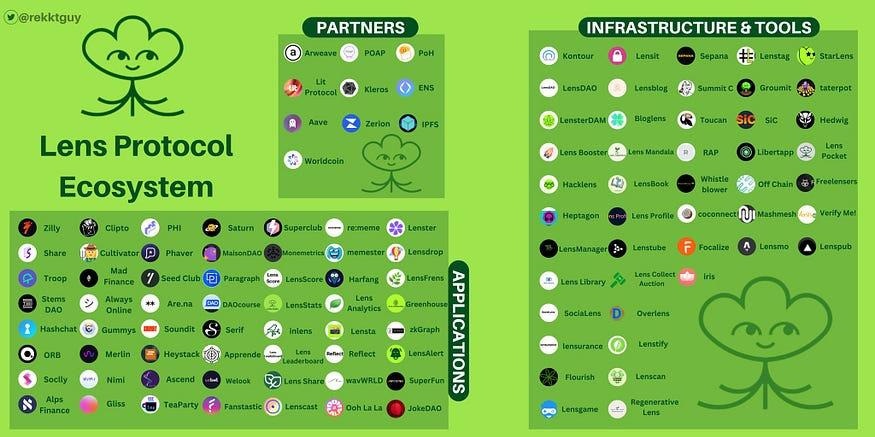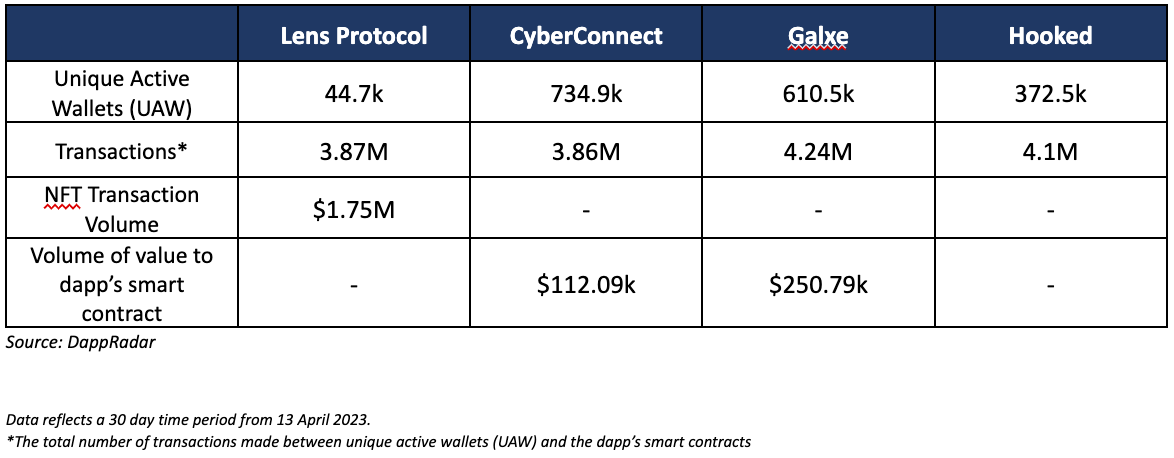Social Media With Web3: A Dive Into Lens Protocol
The Infrastructure Necessary in Shaping the Future of SocialFi?
Disclaimer: The following article is intended to provide an overview of some aspects of web3, a term that refers to the decentralised and distributed applications that run on blockchain technology. The article does not constitute investment advice, nor does it endorse or recommend any specific cryptocurrency, project, or platform. Cryptocurrencies are highly volatile and risky assets that may lose value rapidly and unpredictably. You should do your own research and consult a professional financial advisor before making any investment decisions involving cryptocurrencies. The information shared in this article is purely for educational purposes and does not reflect the opinions or views of the author or any affiliated organization.
What is SocialFi/Web3 Social?
Web3 Social and SocialFi have been used interchangeably but generally refers to the same thing. It’s a term that refers to the intersection of social media and decentralised finance (DeFi) on the web3 ecosystem. As a rule of thumb, everything that the blockchain tech touches can be seamlessly integrated with finance – in this case DeFi. SocialFi has the potential to revolutionise the way we create, share and monetize content online, by empowering users with more control, ownership and rewards over their digital assets and interactions. However, SocialFi is not just about adding tokens or NFTs to existing platforms. It requires a comprehensive infrastructure that can support the complex and dynamic needs of social media creators and users in a decentralised and scalable way.
In this article, I will take a deeper look into Lens Protocol, one of the most promising projects in the SocialFi space. Lens Protocol aims to provide a universal protocol for social media platforms to integrate with web3 and DeFi, enabling users to access a variety of services and benefits across different networks and applications. I will explore how Lens Protocol works, what are its main features and benefits, and how it can help shape the future of SocialFi. I will also discuss some of the challenges and opportunities that Lens Protocol faces in its quest to become the standard for web3 social media.
Why should you even care about SocialFi?
Here’s why. We believe SocialFi could be a paradigm shift that enables users to own and monetize their online interactions, identities and data, while also benefiting from the innovation and opportunities of DeFi. We don’t see SocialFi as just a new feature or a niche market, but a fundamental transformation of how we communicate, collaborate and create value on the internet.
One way to understand the potential of SocialFi is to draw parallels with how relational databases revolutionise the information technology industry. Relational databases are a type of data structure that allows for efficient storage, retrieval and manipulation of data across multiple tables. They are widely used in the most used applications out there. Examples of apps that would not have been possible without the invention of relational databases would be Facebook, Airbnb, Spotify and other platforms that utilise SQL – this trickles down to many more in enterprise software, e-commerce, banking, health care and much more. Relational databases are not as flashy or visible as some other technologies, such as the iPhone or the web browser, but they are no less important or impactful. They provide the backbone and the foundation for many systems and services that we rely on every day – we believe the backbone to the future of online interactions could potentially be composable and decentralised social graphs.
This can be viewed as a new layer of infrastructure that enables new forms of social and economic interactions on the web3. It leverages the power and flexibility of smart contracts, tokens, NFTs and DAOs to create decentralised platforms and communities that are user-centric, transparent and fair. SocialFi can empower users to have more control and ownership over their online presence, reputation and income, while also fostering innovation and collaboration across different domains and networks. SocialFi is not just about adding financial features to existing social media platforms, but about reimagining and redesigning them from the ground up.
Which brings us to Lens Protocol – a composable decentralised social graph. In this article, I will take a deeper look into one of the more promising projects in the SocialFi space.
What is Lens Protocol?
Lens Protocol is a composable, decentralised and user-owned social graph that any application can plug into. It allows creators to own the links between themselves and their community. The protocol was built by the team behind one the biggest DeFi players - AAVE. It was built to empower creators from the ground up with modularity in mind.
The protocol allows you to create a Web3 native profile that is stored as an NFT (non-fungible token) in your wallet. You can use this profile to interact with any application that supports Lens Protocol, without needing to create a new account or give up your data.
With Lens Protocol, you can also follow other users, create and collect publications (such as posts, tweets, blogs, podcasts, etc.), and join communities. All of these actions are recorded on the blockchain as transactions that link your profile to other profiles or publications.
Uncovering the Root of the major concepts
Lens Protocol relies heavily on NFTs and allows social media platforms to access these NFT-powered features. Users can create profiles, comment, reshare posts and more, but unlike traditional social media systems, they have full ownership and control over their data and content. The protocol offers the following key features:
Profile NFTs:
This is the main primitive of the Lens Protocol. These are non-custodial, permissionless, and composable NFTs that store the history of all your content creation, such as posts, mirrors, comments, etc. Ownership over this NFT gives users control of its content. You can own profile NFTs with your address, have multiple profile NFTs in one address, or even let a DAO control a profile NFT through a multisig wallet.
A differentiator mentioned by the devs of the Lens Profile NFTs from other on-chain identities is the ability to post publications to it.
Publications:
Publications are original content, comments, and mirrors created by users and stored in their ProfileNFTs. They can have different types of content and can be minted or referenced by other users. Publications are not NFTs themselves, but they have modules that enable NFT functionality. Additionally, Lens Protocol supports both decentralised and centralised storage protocols/providers such as IPFS, Arweave and AWS S3.
Publications have attached logic (Collect and Reference Module) in that it allows users to mint the publication as an NFT and determines restrictions on who can comment and mirror the publication.
Comments:
Comments are treated the same as publications – in that it can add feedback to other publications. They belong to the user's Profile NFT and have extra checks and features. Comments must follow the rules of the publication they reference, such as who can comment or mirror. Comments can also be minted into NFTs with their own rules.
Mirrors:
Similar to Comments, Mirrors are treated the same as publications. Mirrors are a way to share content from the Lens Protocol – as how Retweets are to Twitter. They are subject to the rules and features of the original publication intended to repost. For example, some mirrors may need a Follow NFT to be created. Mirrors cannot be collected as its reposting existing content – but can set rules that define what accounts would be able to mirror or comment on the mirror.
Collect:
Collects are a way for creators to monetize their content as NFTs. They use the Lens Protocol to own their content and set the rules for collecting it. Collects can have different conditions such as time limit or quantity limit. Collect modules are the code that defines these conditions and are customisable by devs to add more functionalities. Creators will have more options to creatively monetize content.
Follow:
Lens Protocol allows users to follow profiles and get Follow NFTs with extra benefits. Profiles can set their own rules for issuing Follow NFTs, such as charging a fee or giving priority to early followers. Follow NFTs also enable social governance by letting followers vote on decisions based on different criteria. This creates new possibilities for Social DAOs using Lens Protocol (Influencer DAO anyone..?)
Lens Protocol Ecosystem – As an investor, where to play?
Source: @rekttguy – as at October 18 2022.
An important note to the visual above is that most of these projects are in the pre-seed stage (conceptualised in hackathons) – the objective of displaying this image is to illustrate the potential of the SocialFi ecosystem. This also shows some potential verticals to consider as opportunities for investors.
Native Lens Protocol Tokens:
As of yet, the developers of Lens Protocol have not made an official announcement regarding the launch of a native token, such as "$LENS." However, if such a token were to be launched, it may be worth investigating further. Conducting due diligence on the tokenomics of the native token would be necessary to determine if it would accrue value from network participation of developers building on top of the social graph. It is essential to consider the potential use cases for the token, such as whether it would be utilised by developers, content creators, and users within the ecosystem. The viability of the token's introduction and whether it would create organic demand from users and developers is yet to be seen. The worst-case scenario for the token's success would be if it functions only as a sole-governance token, giving tokenholders a vote on ecosystem direction, but without any final say in decisions. Ultimately, the success of the native token will depend on the careful consideration of tokenomics and use-cases for developers, creators, and users within the Lens Protocol ecosystem. If you are bullish on the social graph and a potential airdrop – participation in the applications could be a starting point.
Another angle to play would be in the profile NFTs. The Lens Protocol Profiles have been listed on the secondary markets and both volume and average price of these NFTs have increased significantly. Since June 2022, total volume has grown ~36X from 2.6875 ETH to 97.99 ETH as at 3 April 2023. During the same period average prices of these profile NFTs has seen a ~24x increase from 0.0042 ETH to 0.1028 ETH.
Source: OpenSea (https://opensea.io/collection/lens-protocol-profiles/activity)
Upon examining the sales of profiles NFTs, we found that the demand was not dependent on the number of followers these profiles had (most had none), but rather on the name itself. The current market dynamics appear to be reminiscent of the Ethereum Name Service (ENS). The demand hype was based on the subjective value in the name – this was seen in the three character hype in mid-2022 where 80% of all ENS addresses registered in 2022 were three digit character addresses.
In terms of rankings in the “Social” category on DappRadar, Lens Protocol currently sits in 4th place behind CyberConnect, Galxe and Hooked. Comparable protocols to Lens Protocol would be Galxe, CyberConnect and Hooked. Galxe is positioned as a Web3 Credential Data Network; CyberConnect as a web3 social graph; and Hooked as Web3 gamified social learning platform.
Source: DappRadar
Lens Protocol still has some ways to go in terms of UAW but fair well in number of transactions. This can be attributed to the social graph protocol still early in its development with a majority of its dApps in the ecosystem still in its nascent stage. An interesting observation here would be the volume of transactions despite being a fairly new entrant in the space. The recent volume can be attributed to rumours of a potential Lens Protocol airdrop. As seen in the chart below, the recent spike in UAW was the highest to date because of the Airdrop rumour – prior to that was the spike in November when the protocol allowed users to claim their Lens handle. The metrics currently shows that Lens Protocol is yet to gain significant onboarding – and that most of the volume are due to unsustainable hype.
However as the protocol matures, we are expecting for the market dynamics for profile NFTs to evolve to be driven by factors such as the number of followers or the value of the content associated with the profile. Nonetheless, it is still too early to predict such changes, and we will continue to monitor the market activity closely in the future.
dApps:
There may be two ways of “investing” in this particular area – participate in the dApps as a content creator or participate as a user to earn potential airdrops. Below are some dApps that may be of interest.
Lenster
A social media dapp similar to twitter.
Link: https://lenster.xyz
Lenstube
A video sharing dapp.
Link: lenstube.xyz
Orb
A Super App for Social Media.
Link: orb.ac
Phaver
Share-to-earn social media dapp.
Link: phaver.com
Share
Share is a Web3 social writing platform where authors can publish writings as digital collectibles and readers can interact with their favourite authors.
Link: theshr.xy
OHH LA LA
Music and podcast NFT Player.
Link: oohlala.xyz
What’s the Thesis? Bullish or Bearish?
Lens Protocol leverages the power of crypto to provide a decentralised and composable backend for social media platforms. Front-ends will be pure design powered by composable decentralised social graphs - similar to how Balaji Srinivasan mentions that crypto is the backend and FinTech being the frontend. This can be a game-changer in innovating business models related to the creator economy – which is seen to be a market that has been gaining traction over pure e-commerce plays. By using Lens Protocol as the backend, developers can tap into a rich and open social graph that connects users across different platforms and contexts – providing huge depth in creatively engineering business models that would emerge only with the existence of composable decentralised social graphs. Front-ends could participate in fee-sharing, incentivising existing and new social media platforms to participate. This would shift the focus of platforms and creators from worrying about network effects and focus on finding innovative ways to interact with communities, which would lead to new business models.
The key to mass adoption of Web3 SocialFi would depend on the developers, content-creators, and businesses who work with the protocols. They can leverage the advantages of the decentralised and composable nature of the systems to maximise productivity. This can be done without the end-users having to know anything about the backend. They only need to interact with user-friendly interfaces that provide them with better services and experiences – all users care about are ease of use, cheaper costs and faster service. We believe that key drivers in participating with Lens Protocols (and other composable decentralised social graphs) for the developers in the space to be the philosophical reasoning of a decentralised future and the driver for the users would be the convenience, affordability and performance powered by the front-end. It’s a win-win.
Thank you for reading our first article on web3 and social media. If you enjoyed this article, consider giving our author, Za’im Zainudin, a follow.









